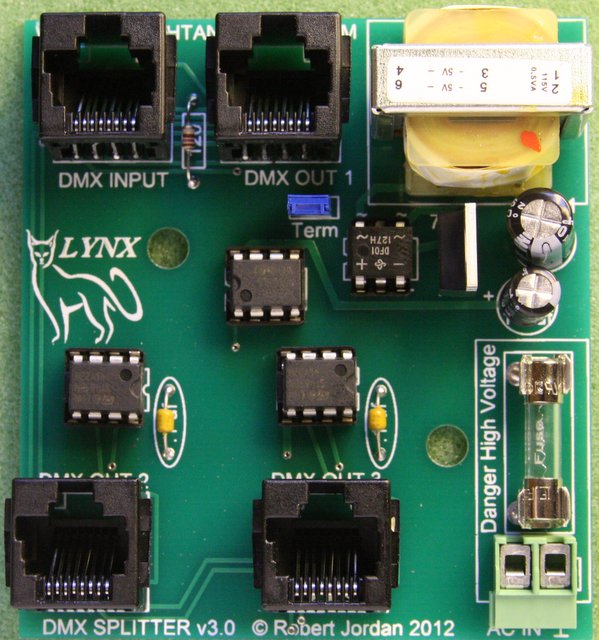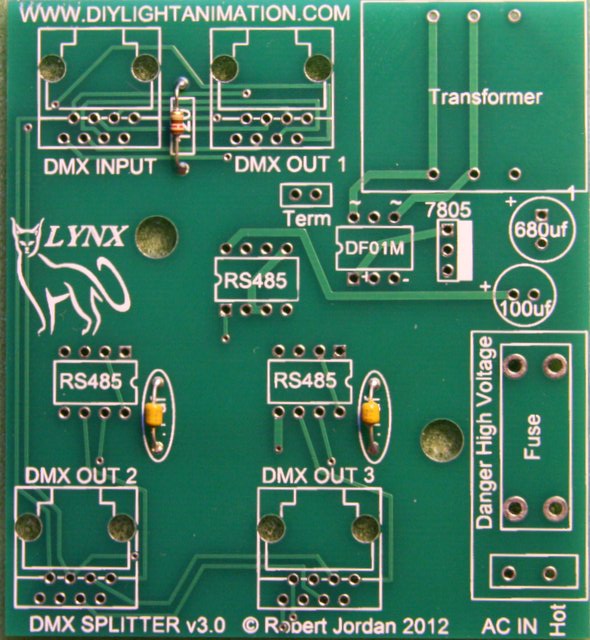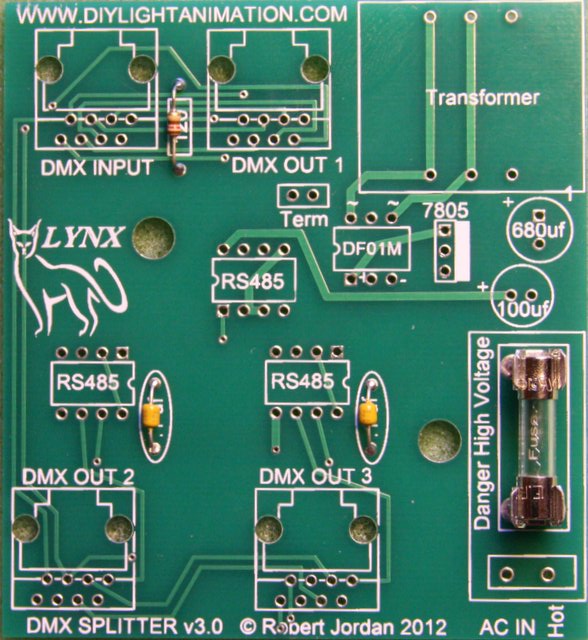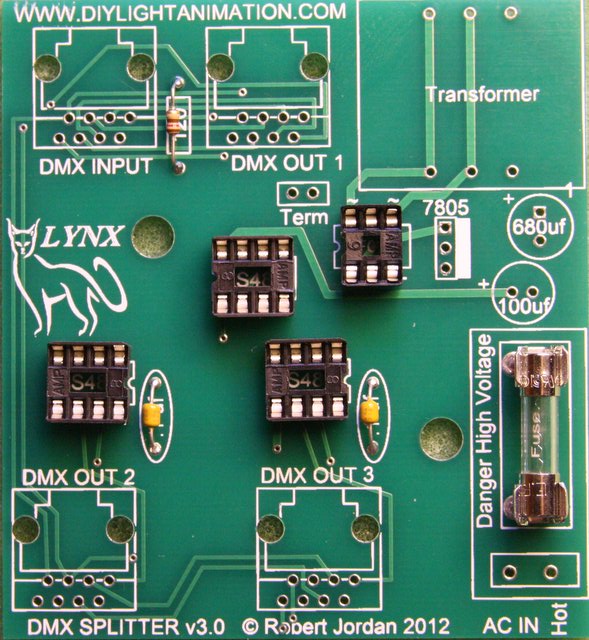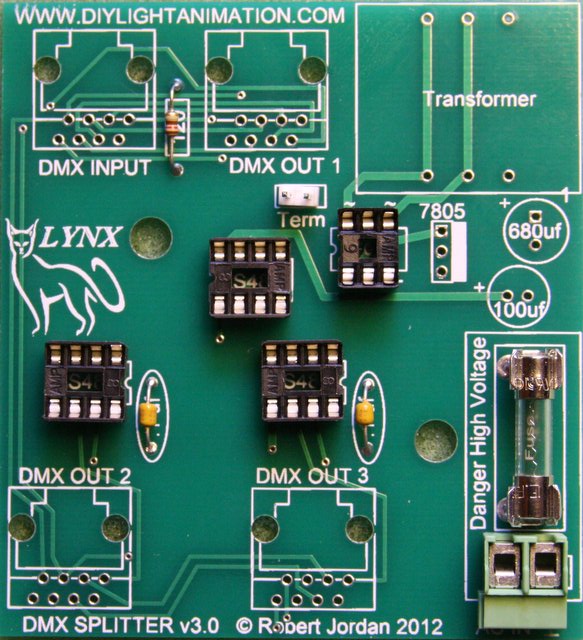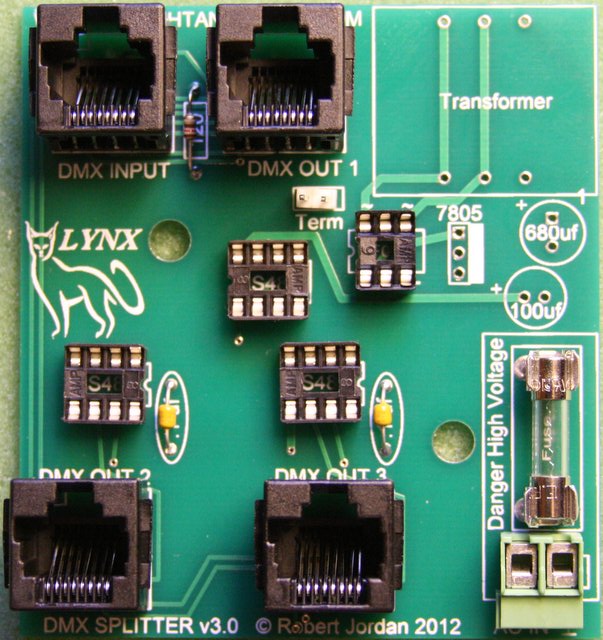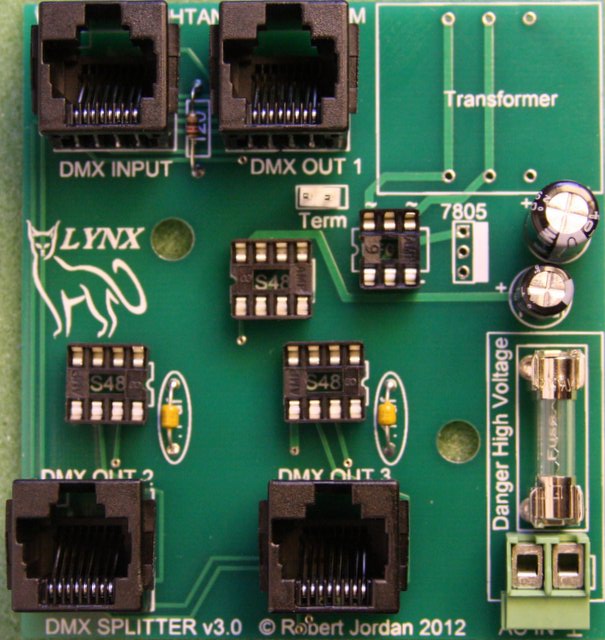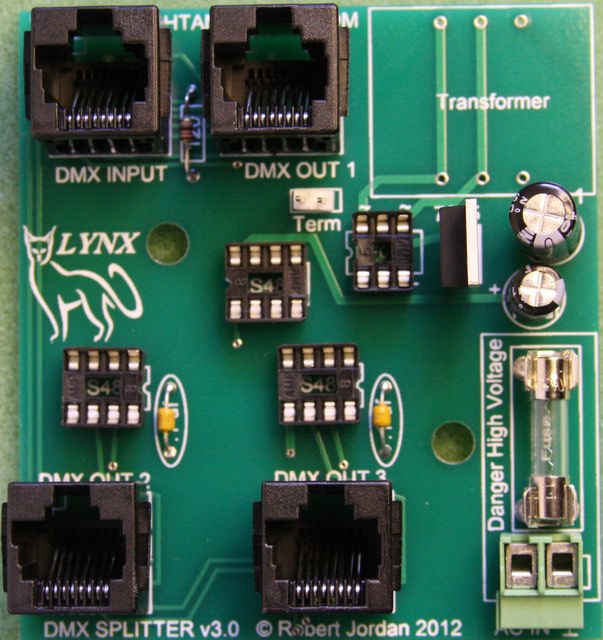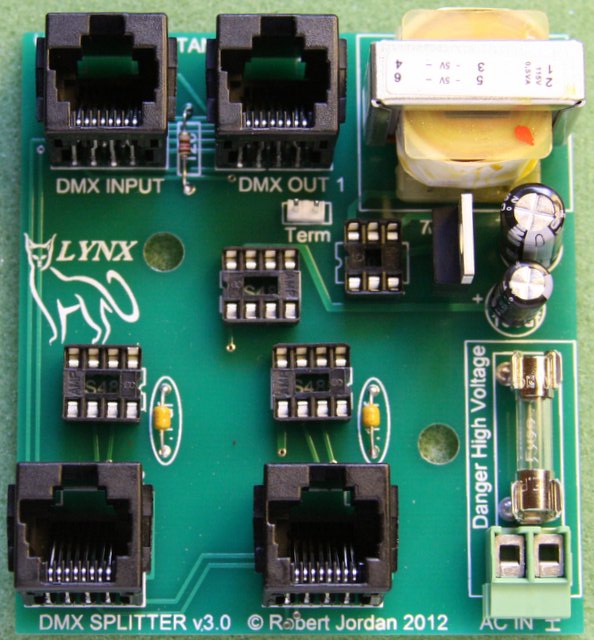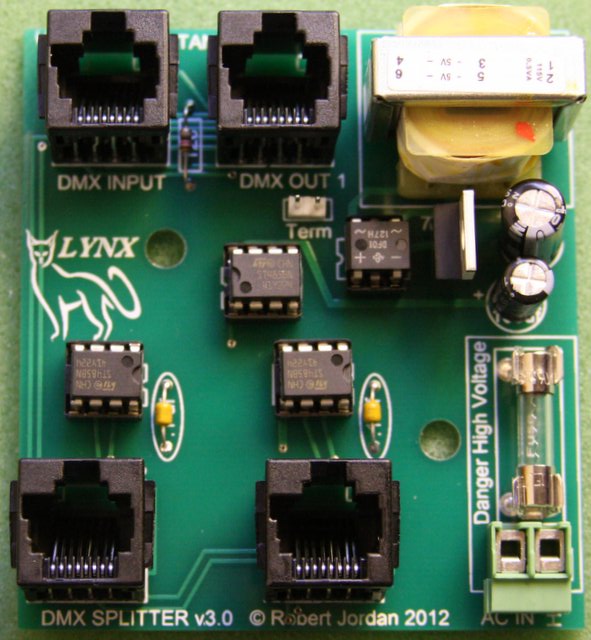Difference between revisions of "Manual Splitter"
(→Parts List) |
(v3 manual by mokeefe) |
||
| Line 1: | Line 1: | ||
| − | + | '''LYNX DMX Splitter V3.0 Assembly Manual''' | |
| − | [[Image: | + | [[Image:IMG_8560.JPG|600px|Thumb]] |
= Introduction = | = Introduction = | ||
| − | Thank you for making the decision to build the LYNX Splitter. I believe this decision will be one you will be very happy with. This splitter was my attempt to design a way to reduce some daisy chaining of the dimmers and also increase the number of devices per a DMX universe. The goals for the splitter were professional looks and operation, cost effective, easy to assemble for even a novice builder, DMX compatible. | + | Thank you for making the decision to build the LYNX Splitter. I believe this decision will be one you will be very happy with. This splitter was my attempt to design a way to reduce some daisy chaining of the dimmers and also increase the number of devices per a DMX universe. The goals for the splitter were professional looks and operation, cost effective, easy to assemble for even a novice builder, and DMX compatible. |
| Line 17: | Line 17: | ||
= Preparing to Build = | = Preparing to Build = | ||
| + | |||
| + | |||
The next thing we want is to make sure you are up to speed on soldering and electrostatic protection of the components in your kit. If you are not an experienced printed circuit builder I recommend you visit the site: | The next thing we want is to make sure you are up to speed on soldering and electrostatic protection of the components in your kit. If you are not an experienced printed circuit builder I recommend you visit the site: | ||
| Line 29: | Line 31: | ||
You will need a few tools that do not come with your kit to build the Splitter. You will need a good soldering iron. I can not stress enough that a good soldering iron makes a big difference in these projects. The little 15w cheap irons are more apt to hurt your parts by taking too long to get the parts up to soldering temperature than a good iron which can bring it up to temp very fast. Remember it is more how long you keep the part hot than it is how hot you get it within reasonable soldering temperatures. A good soldering iron can be had for very reasonable amounts of money. You can purchase one for $30 to $60 dollars. Most anything that is called a soldering station where there is a temperature control separate from the iron itself will more than likely be fine but make sure it is rated for more than 15 watts. I myself use a cheap Weller like this one | You will need a few tools that do not come with your kit to build the Splitter. You will need a good soldering iron. I can not stress enough that a good soldering iron makes a big difference in these projects. The little 15w cheap irons are more apt to hurt your parts by taking too long to get the parts up to soldering temperature than a good iron which can bring it up to temp very fast. Remember it is more how long you keep the part hot than it is how hot you get it within reasonable soldering temperatures. A good soldering iron can be had for very reasonable amounts of money. You can purchase one for $30 to $60 dollars. Most anything that is called a soldering station where there is a temperature control separate from the iron itself will more than likely be fine but make sure it is rated for more than 15 watts. I myself use a cheap Weller like this one | ||
| − | [http://www.amazon.com/Weller-Soldering-Station-WLC100-120V/dp/B000ICEMYA http://www.amazon.com/Weller-Soldering-Station-WLC100-120V/dp/B000ICEMYA] | + | '''Solder Stations:''' |
| + | *[http://www.amazon.com/Weller-Soldering-Station-WLC100-120V/dp/B000ICEMYA http://www.amazon.com/Weller-Soldering-Station-WLC100-120V/dp/B000ICEMYA]Weller WLC100 | ||
| − | |||
| + | It works fine and is very inexpensive. I even saw this model on sale at Sears. Radio Shack has a very nice looking Digital Soldering Station (Model #64-053) for sale but you can't order the tips directly from Radio Shack. You need to order them directly from the manufacturer at [http://www.madelltech.com/nozzles-tips.html Madell Tech's website]. A forum member uses this iron at his business and on the road and it's been rock solid. | ||
| − | |||
| + | Another recommended Solder Station is the MPJA 302A is has a digital temperature readout | ||
| + | *[http://www.mpja.com/prodinfo.asp?number=15141+TL http://www.mpja.com/prodinfo.asp?number=15141+TL]MPJA Model 302A | ||
| − | |||
| − | + | What ever you get make sure and get 4 - 5 extra tips for it. It is an opinion thing but I prefer and find most prefer Chisel tips. get a couple .8 and a few 1.6 to see which you like and then you are ready to go. The tips do wear out and need replacement from time to time. I can build maybe 4 to 8 big controllers (FS, Etc) with a single tip but when you are learning you will use them up faster. | |
| − | + | ||
| − | + | You need solder so buy some. I recommend .032 size (0.8mm or 0.7mm) as the larger sizes tend to cause you to put too much solder on. How much? Go ahead and get a 1 lb spool as it’s cheaper in large volume and you will go through it faster than you think. Make sure you are getting rosin core for electronics they make some solder for plumbing that has acid as the core this is a bad mistake to make. | |
| − | + | You need some work area to work with good lighting. Do not attempt to solder circuit boards in poorly lighted areas. If you wear reading glasses go get them you will want them I promise you. I recommend a set of helping hands like this: [http://www.radioshack.com/product/index.jsp?productId=3928375 http://www.radioshack.com/product/index.jsp?productId=3928375] | |
| − | |||
| − | |||
| + | =STEP 1 - Installing the Ceramic Capacitors and Resistor= | ||
| − | |||
| − | + | [[Image:IMG_8517.JPG]] | |
| − | + | Install the two 0.1uF ceramic capacitors. The orientation does not matter. | |
| + | Install the 120 ohm (brown-red-brown) resistor. The orientation does not matter. | ||
| − | + | Solder and trim leads. | |
| − | + | =STEP 2 - Installing the Fuse and Holder= | |
| − | |||
| − | + | [[Image:IMG_8520.JPG]] | |
| − | |||
| − | + | Find the fuse and the two fuse clips and lock the clips on the fuse. Insert the assembly into the holes marked for the fuse. | |
| + | Solder this into place. It will take more heat than the smaller parts so you may want to bump the temperature up on you iron. Make sure to turn it back down after soldering the fuse. | ||
| − | |||
| − | = STEP 3 | + | = STEP 3 - Installing the IC Sockets= |
| − | + | ||
| − | [[Image: | + | [[Image:IMG_8523.JPG]] |
| − | + | Begin by opening and removing all of the IC sockets (DIP sockets). The socket locations all have rectangles with little round notches on one end of them with the other end being flat. The notched end is the end that pin #1 of the chip will go to. | |
| + | Install the three 8 Pin IC sockets in the areas labeled RS485. Make sure the round notch at one of the socket lines up with the notch on the board. | ||
| − | Install the | + | Install the 6 Pin IC socket in the area labeled DF01M. Make sure it is oriented correctly. |
| + | Solder all the pins on the 4 sockets. | ||
| − | |||
| − | + | =STEP 4 - Installing the Jumper Header and AC IN Terminal= | |
| − | |||
| − | + | [[Image:IMG_8524.JPG]] | |
| − | |||
| − | |||
| − | When installing the AC cord make sure you put the hot(typically black wire or smooth side) wire in the location marked | + | Install the 2 pin jumper header in the area labeled "Term". The short side of the pins go into the PCB. |
| + | |||
| + | Install the green power screw terminal in the area labeled "AC IN". Make sure the screws face to the bottom edge of the board. | ||
| + | |||
| + | Solder the header and terminal. | ||
| + | |||
| + | |||
| + | =STEP 5 - Installing the RJ-45 Connectors= | ||
| + | |||
| + | |||
| + | [[Image:IMG_8529.JPG]] | ||
| + | |||
| + | |||
| + | Install the 4 RJ45 jacks in the DMX INPUT and DMX OUT areas of the board. They will snap in tight so make sure to align the small pins correctly and then support the board as you push them in. It takes effort to snap them in so support the PCB while you do this. Some like to put the PCB on foam and do it where the foam allows it to support the PCB. | ||
| + | |||
| + | Solder the 8 pins each of the four sockets. | ||
| + | |||
| + | |||
| + | =STEP 6 - Installing the 2 Electrolytic Capacitors= | ||
| + | |||
| + | |||
| + | [[Image:IMG_8533.JPG]] | ||
| + | |||
| + | |||
| + | Install the round 680uf electrolytic capacitor into the board. Make sure the white band marked “-“ is '''NOT''' on the side with the “+” on the board. | ||
| + | |||
| + | Install the round 100uf electrolytic capacitor into the board. Make sure the white band marked “-“ is '''NOT''' on the side with the “+” on the board. | ||
| + | |||
| + | Solder the capacitors and trim the excess leads. | ||
| + | |||
| + | |||
| + | =STEP 7 - Installing the 5 Volt Regulator= | ||
| + | |||
| + | |||
| + | [[Image:IMG_8537.JPG]] | ||
| + | |||
| + | |||
| + | Install the 5V regulator in the location marked "7805". Make sure and face the flat metal side of it towards the white rectangle (right) side of the part outline on the board. | ||
| + | |||
| + | Solder the 3 pins and trim the excess. | ||
| + | |||
| + | Note: The regulator part may be labeled 7805 or TS2940. These are equivalent components. | ||
| + | |||
| + | |||
| + | =STEP 8 - Installing the Transformer= | ||
| + | |||
| + | |||
| + | [[Image:IMG_8552.JPG]] | ||
| + | |||
| + | |||
| + | Install transformer. Although not labeled on the PCB, make sure the numbers 1 & 2 on the top of the transformer are facing the right side as shown in the photo. | ||
| + | |||
| + | |||
| + | Solder the 6 pins. | ||
| + | |||
| + | |||
| + | =Final Assembly= | ||
| + | |||
| + | |||
| + | [[Image:IMG_8543.JPG]] | ||
| + | |||
| + | |||
| + | Install the DF01M IC into the 6 pin socket. Make sure the + and - labels on the chip are at the bottom and the ~ symbols at the top. | ||
| + | |||
| + | Install the 3 RS485 IC's into the 3 remaining sockets. Make sure the notch at the end of the chip aligns with the notch on the socket. Note that the 3 chips do '''NOT''' all face the same direction. | ||
| + | |||
| + | Make sure you put the chips in very carefully and do not bend any pins as they sometimes can be a challenge to insert straight. Take your time here and before pushing them in look over both side to make sure all pins are started straight. '''TAKE YOUR TIME HERE!''' | ||
| + | |||
| + | When installing the AC cord make sure you put the hot(typically black wire or smooth side) wire in the location marked "Hot". The remaining neutral wire gets screwed down in the other terminal. | ||
| + | |||
= Note = | = Note = | ||
| − | |||
| − | |||
| − | |||
| − | |||
| − | |||
| − | + | ||
| + | *Each of the outputs can support up to 32 devices but you are still limited to the 512 channels per DMX Universe (Dongle). | ||
| + | *The "Term" jumper is only needed if the output '''Next To''' the DMX input doesn't have anything hooked to it. | ||
| − | + | '''Congratulation you have a finished DMX Splitter''' | |
| − | + | '''REMEMBER ALWAYS HAVE IT POWERED OFF WHEN WORKING WITH IT. BE SAFE!''' | |
| − | |||
| + | Thank you, enjoy your Splitter and | ||
| − | + | MAY GOD BLESS YOU IN ALL YOU DO! | |
| − | + | *V1.0 & V2.0 Manual Created by RJ | |
| − | + | *V3.0 Manual Updated by mokeefe | |
| − | + | ||
Latest revision as of 18:23, 5 August 2012
LYNX DMX Splitter V3.0 Assembly Manual
Contents
- 1 Introduction
- 2 Preparing to Build
- 3 STEP 1 - Installing the Ceramic Capacitors and Resistor
- 4 STEP 2 - Installing the Fuse and Holder
- 5 STEP 3 - Installing the IC Sockets
- 6 STEP 4 - Installing the Jumper Header and AC IN Terminal
- 7 STEP 5 - Installing the RJ-45 Connectors
- 8 STEP 6 - Installing the 2 Electrolytic Capacitors
- 9 STEP 7 - Installing the 5 Volt Regulator
- 10 STEP 8 - Installing the Transformer
- 11 Final Assembly
- 12 Note
Introduction
Thank you for making the decision to build the LYNX Splitter. I believe this decision will be one you will be very happy with. This splitter was my attempt to design a way to reduce some daisy chaining of the dimmers and also increase the number of devices per a DMX universe. The goals for the splitter were professional looks and operation, cost effective, easy to assemble for even a novice builder, and DMX compatible.
WARNING! This device uses potentially deadly voltages in operation. If you do not feel it is within your ability to work with these voltages please stop and get assistance. This splitter has been design for personal use as a means of education and entertainment. As such it is not rated, tested, or approved for use in commercial environments and as such is forbidden by the designer. Improper use of this equipment could be hazardous to life and property and the suitability of use is your responsibility. I assume no responsibility in the use or operation of this equipment or for the accuracy of any information made on part of itself. This device has been design for my use and my use only. This is simply an explanation of how I built my own personal devices for informational purposes. I make no warranties written or otherwise to it. It should be considered an experimental device with possible unknown characteristics.
Please use static precautions in the handling of these parts. If you are not familiar in them please research on the Internet prior to handling them. You can damage your parts with improper handling!
Preparing to Build
The next thing we want is to make sure you are up to speed on soldering and electrostatic protection of the components in your kit. If you are not an experienced printed circuit builder I recommend you visit the site:
http://curiousinventor.com/guides/How_To_Solder
And check out there extremely good video on soldering correctly. Even if you are an expert it is a good video to watch.
Another issue you must be aware of is that some electronic components can be damaged easily by electrostatic charges that can build up in you or your equipment. We have all been shocked by walking on carpet and grabbing a door knob before. This is electrostatic charge in action. It takes much less than this to hurt some of our parts. If you are unfamiliar with procedures to protect from this please use the internet to research it before opening your parts up. You can damage your parts if handled wrong!
You will need a few tools that do not come with your kit to build the Splitter. You will need a good soldering iron. I can not stress enough that a good soldering iron makes a big difference in these projects. The little 15w cheap irons are more apt to hurt your parts by taking too long to get the parts up to soldering temperature than a good iron which can bring it up to temp very fast. Remember it is more how long you keep the part hot than it is how hot you get it within reasonable soldering temperatures. A good soldering iron can be had for very reasonable amounts of money. You can purchase one for $30 to $60 dollars. Most anything that is called a soldering station where there is a temperature control separate from the iron itself will more than likely be fine but make sure it is rated for more than 15 watts. I myself use a cheap Weller like this one
Solder Stations:
It works fine and is very inexpensive. I even saw this model on sale at Sears. Radio Shack has a very nice looking Digital Soldering Station (Model #64-053) for sale but you can't order the tips directly from Radio Shack. You need to order them directly from the manufacturer at Madell Tech's website. A forum member uses this iron at his business and on the road and it's been rock solid.
Another recommended Solder Station is the MPJA 302A is has a digital temperature readout
- http://www.mpja.com/prodinfo.asp?number=15141+TLMPJA Model 302A
What ever you get make sure and get 4 - 5 extra tips for it. It is an opinion thing but I prefer and find most prefer Chisel tips. get a couple .8 and a few 1.6 to see which you like and then you are ready to go. The tips do wear out and need replacement from time to time. I can build maybe 4 to 8 big controllers (FS, Etc) with a single tip but when you are learning you will use them up faster.
You need solder so buy some. I recommend .032 size (0.8mm or 0.7mm) as the larger sizes tend to cause you to put too much solder on. How much? Go ahead and get a 1 lb spool as it’s cheaper in large volume and you will go through it faster than you think. Make sure you are getting rosin core for electronics they make some solder for plumbing that has acid as the core this is a bad mistake to make.
You need some work area to work with good lighting. Do not attempt to solder circuit boards in poorly lighted areas. If you wear reading glasses go get them you will want them I promise you. I recommend a set of helping hands like this: http://www.radioshack.com/product/index.jsp?productId=3928375
STEP 1 - Installing the Ceramic Capacitors and Resistor
Install the two 0.1uF ceramic capacitors. The orientation does not matter.
Install the 120 ohm (brown-red-brown) resistor. The orientation does not matter.
Solder and trim leads.
STEP 2 - Installing the Fuse and Holder
Find the fuse and the two fuse clips and lock the clips on the fuse. Insert the assembly into the holes marked for the fuse.
Solder this into place. It will take more heat than the smaller parts so you may want to bump the temperature up on you iron. Make sure to turn it back down after soldering the fuse.
STEP 3 - Installing the IC Sockets
Begin by opening and removing all of the IC sockets (DIP sockets). The socket locations all have rectangles with little round notches on one end of them with the other end being flat. The notched end is the end that pin #1 of the chip will go to.
Install the three 8 Pin IC sockets in the areas labeled RS485. Make sure the round notch at one of the socket lines up with the notch on the board.
Install the 6 Pin IC socket in the area labeled DF01M. Make sure it is oriented correctly.
Solder all the pins on the 4 sockets.
STEP 4 - Installing the Jumper Header and AC IN Terminal
Install the 2 pin jumper header in the area labeled "Term". The short side of the pins go into the PCB.
Install the green power screw terminal in the area labeled "AC IN". Make sure the screws face to the bottom edge of the board.
Solder the header and terminal.
STEP 5 - Installing the RJ-45 Connectors
Install the 4 RJ45 jacks in the DMX INPUT and DMX OUT areas of the board. They will snap in tight so make sure to align the small pins correctly and then support the board as you push them in. It takes effort to snap them in so support the PCB while you do this. Some like to put the PCB on foam and do it where the foam allows it to support the PCB.
Solder the 8 pins each of the four sockets.
STEP 6 - Installing the 2 Electrolytic Capacitors
Install the round 680uf electrolytic capacitor into the board. Make sure the white band marked “-“ is NOT on the side with the “+” on the board.
Install the round 100uf electrolytic capacitor into the board. Make sure the white band marked “-“ is NOT on the side with the “+” on the board.
Solder the capacitors and trim the excess leads.
STEP 7 - Installing the 5 Volt Regulator
Install the 5V regulator in the location marked "7805". Make sure and face the flat metal side of it towards the white rectangle (right) side of the part outline on the board.
Solder the 3 pins and trim the excess.
Note: The regulator part may be labeled 7805 or TS2940. These are equivalent components.
STEP 8 - Installing the Transformer
Install transformer. Although not labeled on the PCB, make sure the numbers 1 & 2 on the top of the transformer are facing the right side as shown in the photo.
Solder the 6 pins.
Final Assembly
Install the DF01M IC into the 6 pin socket. Make sure the + and - labels on the chip are at the bottom and the ~ symbols at the top.
Install the 3 RS485 IC's into the 3 remaining sockets. Make sure the notch at the end of the chip aligns with the notch on the socket. Note that the 3 chips do NOT all face the same direction.
Make sure you put the chips in very carefully and do not bend any pins as they sometimes can be a challenge to insert straight. Take your time here and before pushing them in look over both side to make sure all pins are started straight. TAKE YOUR TIME HERE!
When installing the AC cord make sure you put the hot(typically black wire or smooth side) wire in the location marked "Hot". The remaining neutral wire gets screwed down in the other terminal.
Note
- Each of the outputs can support up to 32 devices but you are still limited to the 512 channels per DMX Universe (Dongle).
- The "Term" jumper is only needed if the output Next To the DMX input doesn't have anything hooked to it.
Congratulation you have a finished DMX Splitter
REMEMBER ALWAYS HAVE IT POWERED OFF WHEN WORKING WITH IT. BE SAFE!
Thank you, enjoy your Splitter and
MAY GOD BLESS YOU IN ALL YOU DO!
- V1.0 & V2.0 Manual Created by RJ
- V3.0 Manual Updated by mokeefe
